Cerruti R2 Hooks$ and Anahí Espíndola*
$Associate Professor and Extension Specialist
Assistant Professor*, CMNS, Department of Entomology
University of Maryland
Introduction
Insects, especially bees (Hymenoptera), are often considered the most important group of pollinators worldwide. Howbeit, there are other insect orders which are now confirmed to be of similar importance, but receive limited attention for their contribution to pollination. The most important of these groups is flies (Diptera; Fig. 1), which in addition to the familiar house and fruit flies, consist of less-known flies such as syrphids and bee-flies (Fig. 2). Flies have been estimated to contribute to the pollination of at least 70% of food crops, and are the dominant group of pollinators in some environmental settings such as areas in high altitude and latitude, where bees are absent or scarce. Pollination by flies is known as myophily and is economically important. For instance, the annual economic value of fly pollination has been estimated to be US $300 billion. Flies are listed as key pollinators of hundreds of species of cultivated plants (e.g., cacao, mango, cashew, avocado, oilseed rape). Further, the emerging importance of fly pollination is such that flies are currently used commercially to pollinate onion, chive, carrot, strawberry and blackberry crops, and they are being seriously explored as a new managed pollination system for crops.
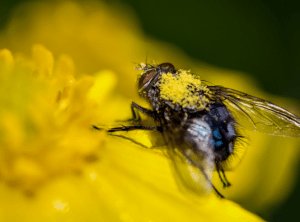
Among all fly families, a few stand out for their strong and widespread contributions to plant pollination: Syrphidae (including syrphids) and Bombyliidae (bee-flies). Together, these groups have been described as contributors to the pollination of a large percentage of plant species, and have been equaled to bees in terms of their ability to pollinate plants. The reason why these two fly groups are important pollinators partially lies in their biology and morphology. As adults they feed exclusively on nectar and/or pollen, meaning that they are consistent flower visitors. Further, their fuzzy appearance, with hairs covering their bodies assists them in transferring pollen between plants.
Bombyliids or bee-flies
The main focus of this article is on syrphids. However, a short overview of bee-flies is provided here as they are also important dipteran pollinators (Fig. 2, right). Bee-flies are flies that externally resemble bumblebees because their bodies are rounded and extremely hairy. They are easily recognizable because of their elongated and forward-pointing feeding apparatus which they can’t retract. Bee-flies can be found regularly in fields hovering around flowers. Unlike Syrphids, these flies are specialized for feeding almost exclusively on nectar, and for that reason they are meticulous flower visitors, collecting nectar from each individual flower present on a plant. Because they have elongated mouth parts, these flies visit open and tubular flowers. Though bee-flies are extremely important pollinators of many wild plants especially in temperate regions, only very recently has it been shown that they contribute significantly to the pollination of some crops and that they are exceptionally abundant in farmlands.
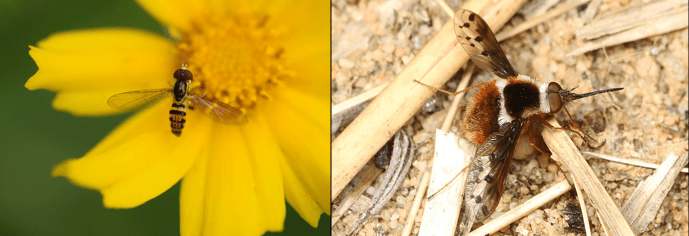
Syrphids (aka hoverflies or flower-flies)
The family Syrphidae, which syrphids belong to is arguably the most recognized group of fly pollinators. While the name flower-flies implies that these dipterans are seen often on flowers, their alternative name “hoverflies” refers to their ability to hover in midflight. Syrphids are ubiquitous and consist of more than 6,000 species worldwide. They can be found in all regions of the world except Antarctica. Syrphids are particularly abundant in habitats of high altitude and latitude, and are important pollinators in forest ecosystems. As adults, syrphids visit generalist flowers, actively foraging on nectar and pollen. Syrphids display a variety of morphologies, such as the marmalade hoverfly, Episyrphus balteatus, and the “drone fly” Eristalis tenax, an excellent bumblebee mimic (Fig. 3).
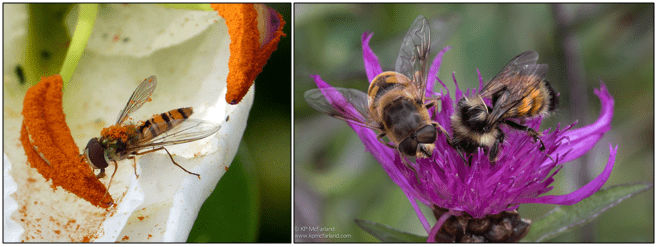
Appearance and life stages
Syrphid adults range in size from ¼ to ~ ¾ inch (3 to 13 mm), and can be metallic, black and yellow, or black and red. These markings and colorations allow them to look like wasps or bees, which is thought to have evolved as a means of protection against predation. However, unlike bees and wasps, syrphids have only two wings (versus four in bees and wasps) that are not held over the back of the body when at rest. Syrphids can fly extremely well, and are able to hover and quickly change directions while in-flight. A characteristic of all syrphids is that they are covered in hairs at least partially, and because this allows for pollen to stick to their bodies they can be efficient pollinators. Though all syrphids are at least partially hairy, some bumblebee or bee mimics are extreme, allowing for an abundant amount of pollen to be transferred between flowers.
Generally, females lay single white eggs on leaves near aphid infestations or other suitable food source for the species (decaying matter, aquatic habitats, etc.). Syrphid eggs are ~ 1/8 inch (3 mm) long and resembles small rice grains. Larvae or maggots hatch from eggs in about 3 days and range in color from creamy white, to green or brown. Larvae develop through several stages (instars) before pupating on the host plant or in the soil. Syrphid larvae are blind and in most species are legless spindle-shaped maggots that vary in color from creamy-white to green or brown, and most display a yellow longitudinal stripe on their back. Larvae differ in size and are roughly the same length as adults, which varies by species and development stage. Larvae look somewhat slug-like and taper to a point at the head end. The skin of the last stage larva forms the oblong, teardrop shaped green puparium, which eventually turns into a tan-brown colored pupa from which the adult emerges (Fig. 4).
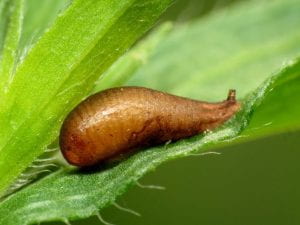
Food/nutrient source
Nutrition in syrphids varies across life-stages. The larvae of some species feed on aphids and other soft-bodied pests of multiple cropping systems. These insectivorous larvae have sucking piercing mouthparts and often lift their prey from the plant surface using their jaws while sucking them dry. Other larvae may feed on pollen, plant material, decaying animal matter, dung and fungus, among other food sources. Nearly all syrphids are pollinators at the adult stage. The adult nutrition is based on the consumption of nectar and/or pollen, and sometimes of insect-produced honeydew. To feed on these resources, adults have sponge-like mouthparts with special conduits that allow for absorbing nectar and pollen grains in solution. A diet based on pollen and nectar is rich in sugars and proteins (pollen is extremely protein-rich), and it has been shown that adult females require feeding on pollen for egg and ovary development. In a study involving sorghum (Sorghum bicolor), larvae and adults of both sexes of the corn-feeding syrphid, Toxomerus politus (Fig. 5) were observed visiting sorghum flowers, where females also laid eggs. It was noted that the highest adult visitation rates occurred when pollen was mature. In that study, because more females than males visited sorghum flowers, this was interpreted as females needing greater pollen amounts to develop their reproductive organs and eggs. Larvae of this insectivorous species were also observed feeding on sorghum pollen. These findings indicate that some syrphids may feed on pollen during their entire life. Toxomerus politus is known to also routinely feed on corn pollen.
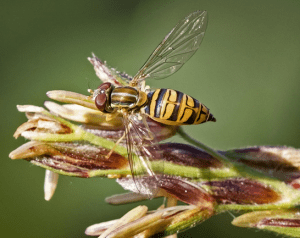
Flower selection
The flower preferences of adult syrphids, and their role in pollination is not well known for many species. However, a large amount of work has recently started to accumulate on this topic. Generally, we know that syrphids prefer yellow and white diurnal flowers, especially those that are radially-symmetric, small and open. Their mouthpart length has some influence on flower selection and varies according to whether they eat nectar, pollen or both. Usually, pollen feeders have a short thick tongue and prefer white and yellow flowers with readily accessible pollen. Pollen and nectar feeders tend to have a much longer, narrower tongue, appropriate for extracting nectar from narrower flowers.
Because they tend to visit generalist flowers (e.g., flat, open and usually grouping many flowers together), syrphids are traditionally viewed as generalized flower visitors. Syrphids have good trichromatic vision, and use floral coloration as a cue for floral visits. Some studies reported that selectivity of some flowers is similar between syrphids within the same subfamilies with comparable body size. Others have reported that selection is dependent on certain plant traits; and that some species are very specialized and have a strong preference for a few plants. However, those preferences can change according to local flower availability and plant phenology, and it is known that syrphids have innate floral preferences, but are also capable of associative learning (i.e., associating floral colors with preferred nectar qualities). Further, because of their ability to learn, males can become very territorial, defending specific selected flowering plants that they identify as their territory. As stated above, syrphids prefer generalist flowers, mostly belonging to the carrot, aster, buttercup, mustard, rose and carnation plant families. When collecting nectar from these plants, syrphids are also quite efficient, visiting systematically all flowers. It is also for this reason that they are considered good pollinators.
Ecosystem services
Pollination. Though syrphids interact directly with pollen by either actively or passively collecting it, only recently, syrphids (and other flies) have been recognized as important pollinators. Indeed, in a series of very recent global analyses, it was estimated that the contribution of syrphids to pollination could be equaled to that of bees, at least in some cases. In contrast to bees, syrphids are more mobile and capable of traveling longer distances, likely dispersing pollen greater distances. Further, many syrphid species are migratory, and these migration events contribute to extreme pollen dispersal, which in Britain has been quantified as involving a number of individuals not much different to that of British managed honeybees at peak population size. Even though it has been long thought that syrphids are mostly “incidental” pollinators, recent studies demonstrate that most individuals are consistent in their floral choices, which tends to suggest that they are not only abundant but also efficient pollinators. Supporting this, some experiments indicate that even though syrphids may carry less pollen grains than bumblebees or bees, flowers visited exclusively by syrphids are better pollinated than those visited exclusively by bumblebees. In addition to mostly visiting a larger variety of flowers than honeybees, syrphids are generally more abundant in natural and agricultural habitats than wild bees. Moreover, syrphids may fill niches that are not covered by larger pollinators. For example, large bumble bees tend to visit large flowers; and the flower complex of some plants such as Solidago virgaurea is small and thus can be effectively pollinated by small syrphid flies (Fig. 6).
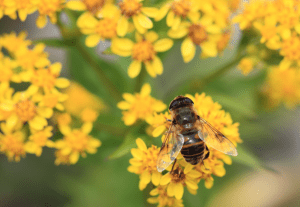
Because of these new discoveries, syrphids are gaining increased interest as legitimate pollinators of agricultural systems. This has led some to consider the use of managed syrphid populations to pollinate crops. A recent global analysis of crops and wildflowers indicated that 72 and 70%, respectively, are visited by syrphids. In terms of fruit set, syrphids appear to be more effective at pollination than honeybees in a range of systems. For instance, syrphids are considered vital pollinators of crops such as oilseed rape Brassica napa (Fig. 7) and wild radish (Raphanus raphanistrum). Further, field studies have estimated the effectiveness of strawberry pollination by the aphidophagous syrphid species, Episyrphus balteatus and Eupeodes latifasciatus, and a mix of four syrphid taxa. These studies indicated that syrphid visitation increased strawberry yields by over 70% and doubled the proportion of marketable fruit, underlining their importance for strawberry pollination and production.
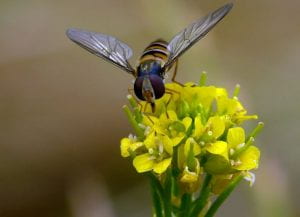
Syrphids also provide key pollinating services to wildflowers, apple trees, soft fruits and other agricultural crops in the mustard family such as broccoli, cabbage and rapeseed, and have been used to successfully pollinate peppers in greenhouses. Though syrphids are key contributors to pollination services, the increased awareness of their importance has been partly due to the global decline in wild and managed bee populations. With the observed decline, there is a need for a greater understanding of the role of syrphid and other flies in plant pollination. It is very likely that the contribution of syrphids to pollination is such that its management could mitigate losses of native bee pollinators, at least in some regions of the world.
Pest suppression. One of the reasons why there is an increased interest in managing syrphids in agricultural landscapes is that they contribute simultaneously to many ecosystem services. In addition to pollination, syrphids are efficient natural enemies of insect pests (Fig. 8). In addition to aphids, syrphid larva feed on thrips, leafhoppers, scales, psyllids, mealybugs, whiteflies and other soft bodied insects, and are commonly found on crops infested by aphids (e.g., fruit trees, grains, corn, alfalfa, grapes, vegetables and ornamentals) as well as wild host plants. They have also been noted as predators of small European corn borer and corn earworm larvae. A single syrphid larva can consume 20 to 30 aphids per day and up to 400 during its development. The syrphid, E. balteatus was estimated to consume a maximum of 396 aphids in wheat during its larval stage. Further, research has shown that when syrphid larvae are numerous, they can reduce aphid populations by 70 to 100%. Because of the ecological nature of their very different life stages, syrphids can serve as well-rounded agricultural allies (i.e., controlling pests at the larval stage and contributing to pollination and fruit/seed production at the adult stage). On this point, syrphids have been shown to benefit strawberry plantings by consuming aphids (aphid control) during their larval stage and pollinating strawberry flowers (enhancing yield) at the adult stage.
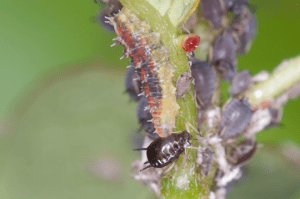
Syrphid conservation
There has been considerable research on the responses of insect pollinators to disturbances caused by agricultural intensification, including loss and fragmentation of natural habitats, altered land use, reduced floral diversity and agri-chemical usage. Syrphids appear to be less impacted by land use changes than bees, as many species are capable of using resources in highly altered habitats, including agricultural fields. However, due to recent losses of domesticated pollinators (e.g., honeybees), there is a need for land managers to establish practices that conserve wild pollinator communities. The diversity of life history strategies exhibited by non-bee pollinators such as syrphids necessitates an approach to conservation that may differ from those used to conserve bees.
The efficacy of aphidophagous syrphids in controlling pests and the conservation of syrphids in general can be improved by planting different flowering plants in protected areas of landscapes. Syrphids feed on pollen and nectar. As such, planting a diversity of flowering plants in the landscape contiguous to crops can serve as a source of nutrients for adults, and bring them in close proximity to crops infested with aphids and/or other small soft bodied pests. Syrphids are especially attracted to flowering plants in the mustard and carrot families, to small-flowered herbs and to sweet alyssum. Studies have shown that planting sweet alyssum in collards and apple orchards increased the number of syrphid flies resulting in reduced aphid infestations and likely higher syrphid populations. In addition to providing syrphids a source of nutrient and enhancing their abilty to suppress pest populations, creative use of flower strips and other vegetation may lead to better pollination of cash crops. Further, because the larval stages of some syrphid species develops on decaying matter, providing habitat for these species to develop (e.g., hedgerows, no-till practices) is key to maintaining large syrphid populations in and close to fields. Finally, avoidance of broad spectrum insecticide usage will be of benefit, especially in flowering crops, as their use can be harmful to syrphids.
Summary
For a long time, bees were considered the superior pollinators, and most other pollinator groups were relegated to agricultural and ecological studies. More recently, studies have shown that flies, and in particular syrphids (aka hover- or flower-flies) play an essential role in the pollination of wild and cultivated plants. Syrphids are now recognized to visit roughly 70% of all wildflowers and crops, and in some cases contributing equally or more than bees to pollination services. Further, their pollination service has an annual estimated value of approximately US $300 billion. Moreover, unlike bees, syrphids have been shown to provide multiple ecosystem services, such as pest control and the degradation of decaying matter (during their larval stages), as well as pollination in their adult stage. The few studies that exist on the evolution of syrphid populations indicate that many species are in decline and that some may be stable. Syrphid conservation plans should take into consideration their variable ecology, promoting the use of land management practices that support their larval and adult stages (e.g., hedgerows, diverse flower plantings, no-till practices, reduction of pesticide use). Financial support for the publication of this article came from a USDA NIFA EIPM grant (award number 2017-70006-27171).
